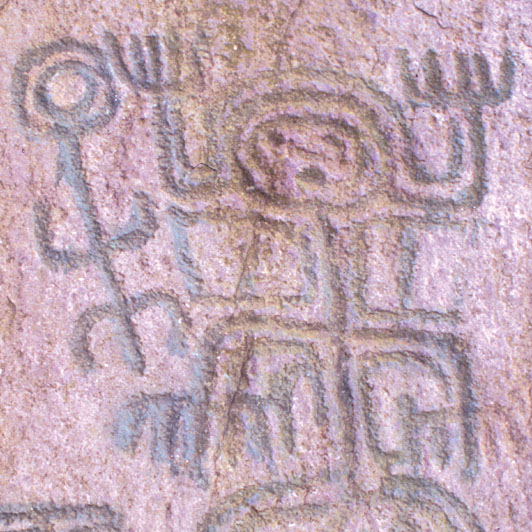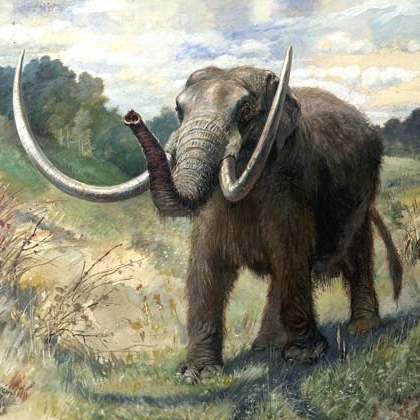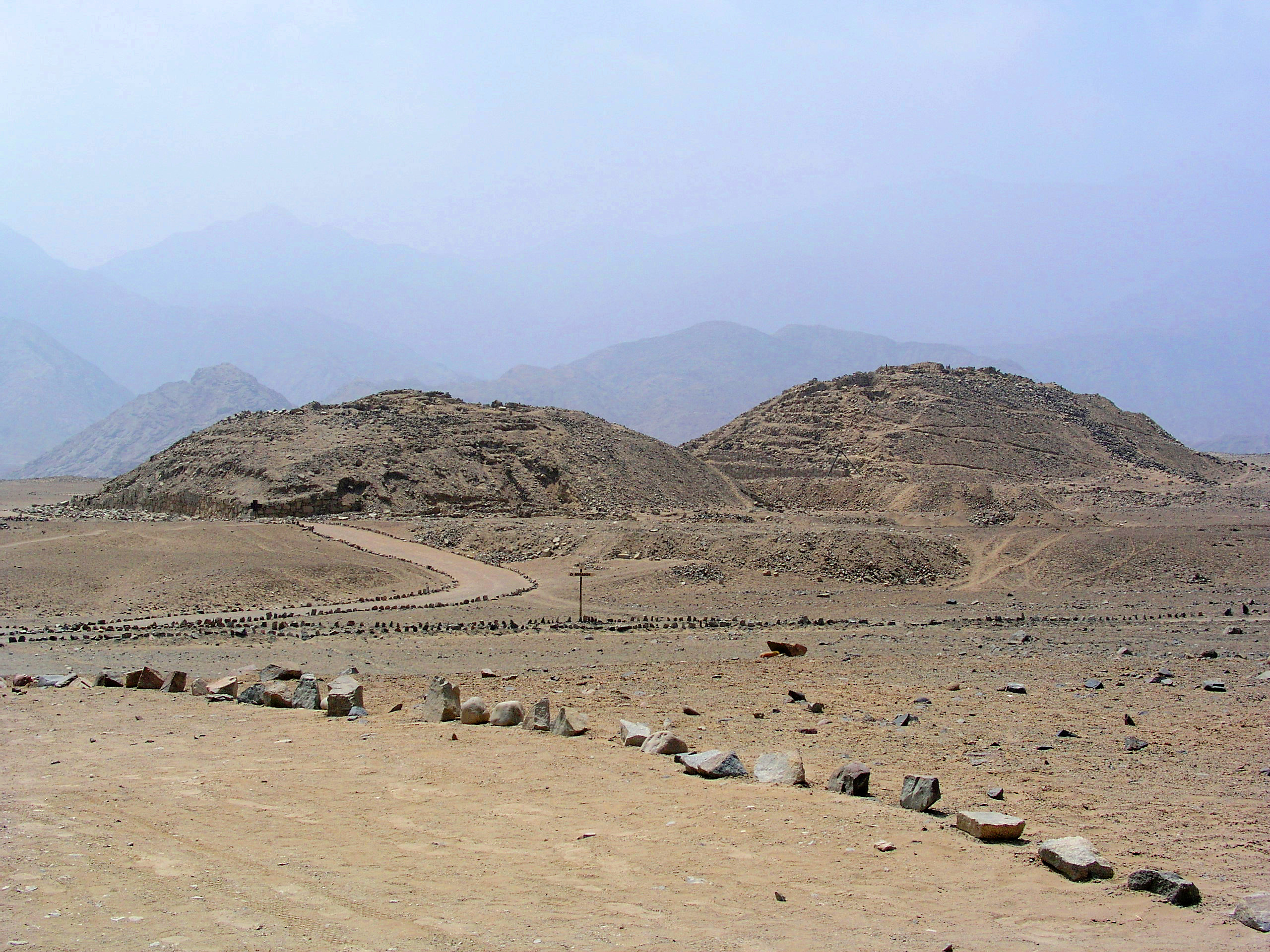|
Aguazuque
Aguazuque is a pre-Columbian archaeological site located in the western part of the municipality Soacha, close to the municipalities Mosquera and San Antonio del Tequendama in Cundinamarca, Colombia. It exists of evidences of human settlement of hunter-gatherers and in the ultimate phase primitive farmers. The site is situated on the Bogotá savanna, the relatively flat highland of the Altiplano Cundiboyacense close to the present-day course of the Bogotá River at an altitude of above sea level. Aguazuque is just north of another Andean preceramic archaeological site; the rock shelter Tequendama and a few kilometres south of Lake Herrera. The artefacts found mostly belong to the preceramic period, and have been dated to 5025 to 2725 BP (3000 to 700 BCE). Thus, the younger finds also pertain to the later ceramic Herrera Period. There were some difficulties in dating of the uppermost layer due to modern agricultural activity in the area; the sediments of the shallower parts wer ... [...More Info...] [...Related Items...] OR: [Wikipedia] [Google] [Baidu] |
Checua
Checua is a preceramic open area archaeological site in Nemocón, Cundinamarca, Colombia. The site is located north of the town centre.Gómez Mejía, 2012, p.146 At Checua, thousands of stone and bone tools, stone flakes and human remains have been found, indicating human occupation from around 8500 to 3000 years BP. Main archaeologist for Checua is Ana María Groot, who published the results of her research in 1992.Groot de Mahecha, 1992 Background The Altiplano Cundiboyacense has been inhabited at least since 12,500 years ago. The first human settlers migrated via the Darién Gap from Central America to South America and led a hunter-gatherer lifestyle. They populated the rock shelters of the high plateau in the Andes, then still with abundant Pleistocene megafauna as ''Cuvieronius'', ''Haplomastodon'', ''Equus amerhippus'' and giant sloths. During this preceramic phase, the population shifted from rock shelters to open area settlement, of which Galindo and Checua are ... [...More Info...] [...Related Items...] OR: [Wikipedia] [Google] [Baidu] |
Bogotá Savanna
The Bogotá savanna is a montane savanna, located in the southwestern part of the Altiplano Cundiboyacense in the center of Colombia. The Bogotá savanna has an extent of and an average altitude of . The savanna is situated in the Eastern Ranges of the Colombian Andes. The Bogotá savanna is crossed from northeast to southwest by the long Bogotá River, which at the southwestern edge of the plateau forms the Tequendama Falls (''Salto del Tequendama''). Other rivers, such as the Subachoque, Bojacá, Fucha, Soacha and Tunjuelo Rivers, tributaries of the Bogotá River, form smaller valleys with very fertile soils dedicated to agriculture and cattle-breeding. Before the Spanish conquest of the Bogotá savanna, the area was inhabited by the indigenous Muisca, who formed a loose confederation of various ''caciques'', named the Muisca Confederation. The Bogotá savanna, known as ''Muyquytá'', was ruled by the ''zipa''. The people specialised in agriculture, the mining of emeralds ... [...More Info...] [...Related Items...] OR: [Wikipedia] [Google] [Baidu] |
El Abra
El Abra is the name given to an extensive archeological site, located in the valley of the same name. El Abra is situated in the east of the municipality Zipaquirá extending to the westernmost part of Tocancipá in the department of Cundinamarca, Colombia. The several hundred metres long series of rock shelters is in the north of the Bogotá savanna on the Altiplano Cundiboyacense, Eastern Ranges of the Colombian Andes at an altitude of . The rock shelter and cave system is one of the first evidences of human settlement in the Americas, dated at 12,400 ± 160 years BP. The site was used by the hunter-gatherers of the Late Pleistocene epoch. Etymology The name El Abra is taken from a large hacienda of that name at the foot of the western portion of the rock formation. The eastern side of the outcropping sandstones is accessible. Climbing activities at these ''Rocas de Sevilla'' are organised. Stratigraphy The first research in the place was conducted in 1967, and the strati ... [...More Info...] [...Related Items...] OR: [Wikipedia] [Google] [Baidu] |
Gonzalo Correal Urrego
Gonzalo Correal Urrego ( Gachalá, Colombia, 23 October 1939) is a Colombian anthropologist, palaeontologist and archaeologist.Curriculum Vitae Gonzalo Correal Urrego He has been contributing to the knowledge of prehistoric Colombia for over forty years and has published in and English.List of publications by Gonzalo Correal Urrego - Correal Urrego is considered one of the ... [...More Info...] [...Related Items...] OR: [Wikipedia] [Google] [Baidu] |
Herrera Period
The Herrera Period is a phase in the history of Colombia. It is part of the Andean preceramic and ceramic, time equivalent of the North American pre-Columbian formative and classic stages and age dated by various archaeologists. The Herrera Period predates the age of the Muisca, who inhabited the Altiplano Cundiboyacense before the Spanish conquest of the Muisca and postdates the prehistory of the region in Colombia. The Herrera Period is usually defined as ranging from 800 BCE to 800 CE, although some scholars date it as early as 1500 BCE. Ample evidence of the Herrera Period has been uncovered on the Altiplano Cundiboyacense. The main archaeologists contributing to the present knowledge about the Herrera Period are the scholars Ana María Groot, Gonzalo Correal Urrego, Thomas van der Hammen, Carl Henrik Langebaek Rueda, Sylvia M. Broadbent, and Marianne Cardale de Schrimpff. Etymology The Herrera Period is named after Lake Herrera (''Laguna de la Herrera'') where archaeol ... [...More Info...] [...Related Items...] OR: [Wikipedia] [Google] [Baidu] |
Tibitó
Tibitó is the second-oldest dated archaeological site on the Altiplano Cundiboyacense, Colombia.Caracterización de los sitios arqueológicos Sabana de Bogotá - The is located in the , [...More Info...] [...Related Items...] OR: [Wikipedia] [Google] [Baidu] |
List Of Muisca And Pre-Muisca Sites
This is a list of Muisca and pre-Muisca archaeological sites; sites on the Altiplano Cundiboyacense, where archaeological evidence has been discovered of the Muisca and their ancestors of the Herrera, preceramic and prehistorical periods. Over the course of the centuries and mainly in the 21st century, many sites with evidences of Muisca and pre-Muisca presence have been found and reported.Caracterización de los sitios arqueológicos Sabana de Bogotá - Muñoz Castiblanco, 2006, p.10Martínez & Botiva, 2004aLópez Estupiñán, 2011Martínez & Botiva, 2004b, p.15 The possibly ... [...More Info...] [...Related Items...] OR: [Wikipedia] [Google] [Baidu] |
List Of Muisca Scholars
This list contains Muisca and pre-Muisca scholars; researchers, historians, archaeologists, anthropologists and other investigators who have contributed to the current knowledge of the Muisca and their ancestors of the prehistory of the Altiplano Cundiboyacense and of the preceramic and ceramic Herrera Periods. Other than the Mesoamericanists and scholars of the Incas, Muisca scholars are not too abundant. Most of the early Muisca knowledge comes from the Spanish conquistadores and missionaries working in the Americas. __NOTOC__ List of Muisca and pre-Muisca scholars See also *List of Muisca research institutes *Muisca *Mayanist * Inca scholars References Bibliography * * * * * * * * * * * * * * * * * * * * * * * * * {{Muisca navbox, Research, state=expanded Scholars Muisca Muisca The Muisca (also called Chibcha) are an indigenous people and culture of the Altiplano Cundiboyacense, Colombia, that formed the Muisca Confeder ... [...More Info...] [...Related Items...] OR: [Wikipedia] [Google] [Baidu] |
Tequendama
Tequendama is a preceramic and ceramic archaeological site located southeast of Soacha, Cundinamarca, Colombia, a couple of kilometers east of Tequendama Falls. It consists of multiple evidences of late Pleistocene to middle Holocene population of the Bogotá savanna, the high plateau in the Colombian Andes. Tequendama was inhabited from around 11,000 years BP, and continuing into the prehistorical, Herrera and Muisca periods, making it the oldest site of Colombia, together with El Abra, located north of Zipaquirá.Nivel Paleoindio. Abrigos rocosos del Tequendama Younger evidences also from the Herrera Period have been found close to the site of Tequendama in Soacha, at the construction site of a new electrical plant. The ... [...More Info...] [...Related Items...] OR: [Wikipedia] [Google] [Baidu] |
Lake Herrera
Lake Herrera is a small lake located at from the urban centre of Mosquera and about west of the capital Bogotá in Cundinamarca, Colombia. The Andean lake has made its name in the Herrera Period, the period in the history of central Colombia before the Muisca Period, after archaeologist Sylvia Broadbent excavated ceramics around Lake Herrera in 1971. Description Lake Herrera is situated on the Bogotá savanna; the southwestern part of the Andean high plateau in the Eastern Ranges; the Altiplano Cundiboyacense. The lake is one of many remainders of the Pleistocene Lake Humboldt. It is the largest remaining natural water reserve on the Bogotá savanna and the reserve belongs to the municipalities Mosquera, Madrid and Bojacá. History Investigations by archaeologist Gonzalo Correal Urrego in 1984 have revealed the existence of a preceramic site with two layers. The oldest layer has been dated at 3410 years BP and the younger layer at 3135 BP. Correal Urrego has discov ... [...More Info...] [...Related Items...] OR: [Wikipedia] [Google] [Baidu] |
Altiplano Cundiboyacense
The Altiplano Cundiboyacense () is a high plateau located in the Eastern Cordillera of the Colombian Andes covering parts of the departments of Cundinamarca and Boyacá. The altiplano corresponds to the ancient territory of the Muisca. The Altiplano Cundiboyacense comprises three distinctive flat regions; the Bogotá savanna, the valleys of Ubaté and Chiquinquirá, and the valleys of Duitama and Sogamoso. The average altitude of the altiplano is about above sea level but ranges from roughly to . Etymology ''Altiplano'' in Spanish means "high plain" or "high plateau", the second part is a combination of the departments Cundinamarca and Boyacá. Geography The limits of the Altiplano are not strictly defined. The high plateau is enclosed by the higher mountains of the Eastern Ranges, with the Sumapaz mountains in the south and Chingaza to the east. The Tenza Valley is located to the east of the Altiplano and the Ocetá Páramo and Chicamocha Canyon are situated to the ... [...More Info...] [...Related Items...] OR: [Wikipedia] [Google] [Baidu] |
Andean Preceramic
The Andean preceramic refers to the early period of human occupation in the Andean area of South America that preceded the introduction of ceramics. This period is also called pre-ceramic or aceramic. Earliest human occupations The earliest humans that came to South America are known as Paleo-Indians. This period is generally known as the Lithic stage. After this came the period that is widely known as Archaic, although there are also some different classifications of this period. The precise classification is complicated because somewhat different terminologies tend to be used for North America and Mesoamerica. The Andean preceramic period would include cultures that belong to Lithic and Archaic stages. Preceramic in Peru The Zaña Valley in northern Peru contains the earliest known canals in South America. These were small stone-lined canals which drew water from streams in the Andes Mountains region. These canals may have been built as early as 4700 BC. A great deal of a ... [...More Info...] [...Related Items...] OR: [Wikipedia] [Google] [Baidu] |






.png)
